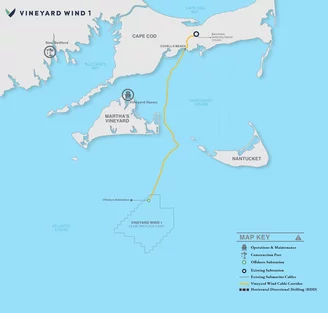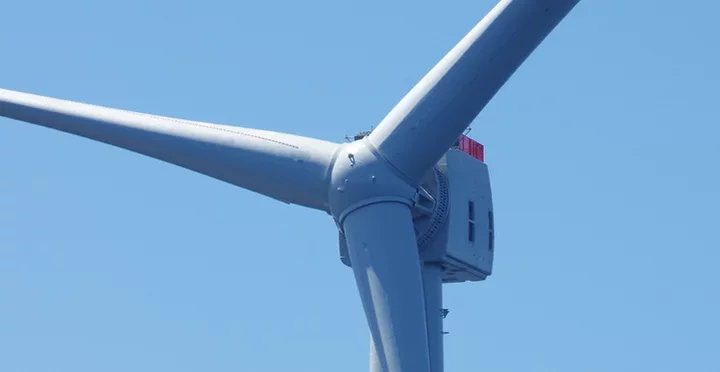Wind turbine under construction at Vineyard Wind 1, located off the coast of Martha’s Vineyard in Massachusetts, in April 2024. Photo: Maia Cheli, Schatz Energy Research Center.
###
Operations were suspended this week at Vineyard Wind 1, an offshore wind farm located about 35 miles off the coast of mainland Massachusetts, after a damaged wind turbine blade broke apart and fell into the ocean. The cause of the incident remains unknown.
Project developer Vineyard Wind, a joint venture between Avangrid and Copenhagen Infrastructure Partners, is an affiliate of Vineyard Offshore, the company planning to build a floating offshore wind farm here on the North Coast.
In a statement issued Monday, Vineyard officials noted that the project is still in its commissioning phase and offered reassurance that the company has “detailed plans to guide its response” to such incidents.
“Following those protocols, Vineyard Wind established a safety perimeter and worked with the U.S. Coast Guard to issue notice to mariners,” the statement says. “GE [Vernova], as the project’s turbine and blade manufacturer and installation contractor, will now be conducting the analysis into the root cause of the incident.”

Map of Vineyard Wind 1. Image: Vineyard Offshore (Click to Enlarge)
Massachusetts officials closed several beaches on Nantucket Island to accommodate debris removal. The 107-meter blade – nearly the length of a football field – left behind “mostly non-toxic fiberglass fragments ranging in size from small pieces to larger sections,” according to Vineyard. A “significant part” of the remaining blade detached from the turbine and fell into the ocean on Wednesday morning. As of this writing, clean-up crews have recovered more than 17 cubic yards of debris.
Reached for additional comment this afternoon, Vineyard spokesperson Kathryn Niforos told the Outpost that the blade’s manufacturer, General Electric Vernova, is responsible for recovery efforts and is tasked with investigating the cause of the incident.
“They are responsible for the blade itself until it’s completely commissioned, tested and turned on; then it turns over to [Vineyard],” she said. “This incident happened in that trial run. The [project] isn’t in full operation yet. So, GE has to answer the cause of this and is ultimately responsible for recovery efforts.”
This isn’t the first time a GE Vernova blade has come apart. A Reuters article published Thursday points to a similar incident that occurred earlier this year at the Dogger Bank A project, located just off the coast of Yorkshire, England. “Several onshore wind turbines in Germany and Sweden have also broken in recent years,” according to the article.
Asked whether Vineyard is reconsidering its relationship with GE Vernova, Niforos declined to comment, saying, “All we can do is recover the debris and wait for the root cause analysis.”
Rob Holmlund, development director for the Humboldt Bay Harbor, Recreation and Conservation District, said Vineyard contacted the district shortly after the incident occurred.
“We are watching closely as Vineyard works to evaluate their damaged blade,” Holmlund told the Outpost. “From my understanding, they have detailed plans to guide their response to such incidents. This is a good opportunity for us to observe how offshore wind energy companies manage unexpected events. We support Vineyard and look forward to seeing how this is resolved. In the meantime, we are proceeding with our project and look forward to applying lessons learned.”
Niforos added that Vineyard is “committed to delivering safe and reliable offshore energy to Northern California” and will work with local stakeholders “to make sure we get that all correct.”
“Offshore wind is a federally regulated industry, and we will follow all of the procedures in developing offshore wind wherever our projects are,” she added.
Reached for additional comment on the matter, Tom Wheeler, executive director of the Environmental Protection Information Center (EPIC), one of the organizations behind the North Coast Offshore Wind group, said blade failure and similar incidents “are recognized to be very rare.”
“Like any machine, offshore wind turbines sometimes experience failure,” Wheeler said. “Nevertheless, I imagine that GE Vernova is pretty embarrassed by this one and we encourage a robust investigation to ensure that this remains an isolated event. But unlike fossil fuel development, when an offshore wind turbine experiences a failure it doesn’t leave birds and beaches covered with oil.”
Additional information about the blade incident can be found on Vineyard’s website.

CLICK TO MANAGE